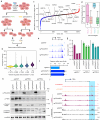A SWI/SNF-dependent transcriptional regulation mediated by POU2AF2/C11orf53 at enhancer
- PMID: 38453939
- PMCID: PMC10920751
- DOI: 10.1038/s41467-024-46492-5
A SWI/SNF-dependent transcriptional regulation mediated by POU2AF2/C11orf53 at enhancer
Abstract
Recent studies have identified a previously uncharacterized protein C11orf53 (now named POU2AF2/OCA-T1), which functions as a robust co-activator of POU2F3, the master transcription factor which is critical for both normal and neoplastic tuft cell identity and viability. Here, we demonstrate that POU2AF2 dictates opposing transcriptional regulation at distal enhance elements. Loss of POU2AF2 leads to an inhibition of active enhancer nearby genes, such as tuft cell identity genes, and a derepression of Polycomb-dependent poised enhancer nearby genes, which are critical for cell viability and differentiation. Mechanistically, depletion of POU2AF2 results in a global redistribution of the chromatin occupancy of the SWI/SNF complex, leading to a significant 3D genome structure change and a subsequent transcriptional reprogramming. Our genome-wide CRISPR screen further demonstrates that POU2AF2 depletion or SWI/SNF inhibition leads to a PTEN-dependent cell growth defect, highlighting a potential role of POU2AF2-SWI/SNF axis in small cell lung cancer (SCLC) pathogenesis. Additionally, pharmacological inhibition of SWI/SNF phenocopies POU2AF2 depletion in terms of gene expression alteration and cell viability decrease in SCLC-P subtype cells. Therefore, impeding POU2AF2-mediated transcriptional regulation represents a potential therapeutic approach for human SCLC therapy.
© 2024. The Author(s).
Conflict of interest statement
The authors declare no competing interests.
Figures






Similar articles
-
Chromatin remodellers as therapeutic targets.Nat Rev Drug Discov. 2024 Sep;23(9):661-681. doi: 10.1038/s41573-024-00978-5. Epub 2024 Jul 16. Nat Rev Drug Discov. 2024. PMID: 39014081 Free PMC article. Review.
-
Targeting the mSWI/SNF complex in POU2F-POU2AF transcription factor-driven malignancies.Cancer Cell. 2024 Aug 12;42(8):1336-1351.e9. doi: 10.1016/j.ccell.2024.06.006. Epub 2024 Jul 18. Cancer Cell. 2024. PMID: 39029462 Free PMC article.
-
Reactivation of the G1 enhancer landscape underlies core circuitry addiction to SWI/SNF.Nucleic Acids Res. 2024 Jan 11;52(1):4-21. doi: 10.1093/nar/gkad1081. Nucleic Acids Res. 2024. PMID: 37993417 Free PMC article.
-
POU2AF2/C11orf53 functions as a coactivator of POU2F3 by maintaining chromatin accessibility and enhancer activity.Sci Adv. 2022 Oct 7;8(40):eabq2403. doi: 10.1126/sciadv.abq2403. Epub 2022 Oct 5. Sci Adv. 2022. PMID: 36197978 Free PMC article.
-
Surgery for limited-stage small-cell lung cancer.Cochrane Database Syst Rev. 2017 Apr 21;4(4):CD011917. doi: 10.1002/14651858.CD011917.pub2. Cochrane Database Syst Rev. 2017. PMID: 28429473 Free PMC article.
Cited by
-
Mammalian SWI/SNF complex activity regulates POU2F3 and constitutes a targetable dependency in small cell lung cancer.Cancer Cell. 2024 Aug 12;42(8):1352-1369.e13. doi: 10.1016/j.ccell.2024.06.012. Epub 2024 Jul 18. Cancer Cell. 2024. PMID: 39029464 Free PMC article.
-
Chromatin remodeling and cancer: the critical influence of the SWI/SNF complex.Epigenetics Chromatin. 2025 Apr 23;18(1):22. doi: 10.1186/s13072-025-00590-w. Epigenetics Chromatin. 2025. PMID: 40269969 Free PMC article. Review.
-
Molecular Subtypes and Targeted Therapeutic Strategies in Small Cell Lung Cancer: Advances, Challenges, and Future Perspectives.Molecules. 2025 Apr 12;30(8):1731. doi: 10.3390/molecules30081731. Molecules. 2025. PMID: 40333678 Free PMC article. Review.
-
Chromatin remodellers as therapeutic targets.Nat Rev Drug Discov. 2024 Sep;23(9):661-681. doi: 10.1038/s41573-024-00978-5. Epub 2024 Jul 16. Nat Rev Drug Discov. 2024. PMID: 39014081 Free PMC article. Review.
References
MeSH terms
Substances
Grants and funding
LinkOut - more resources
Full Text Sources
Medical
Molecular Biology Databases
Research Materials

